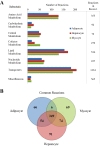A multi-tissue type genome-scale metabolic network for analysis of whole-body systems physiology
- PMID: 22041191
- PMCID: PMC3219569
- DOI: 10.1186/1752-0509-5-180
A multi-tissue type genome-scale metabolic network for analysis of whole-body systems physiology
Abstract
Background: Genome-scale metabolic reconstructions provide a biologically meaningful mechanistic basis for the genotype-phenotype relationship. The global human metabolic network, termed Recon 1, has recently been reconstructed allowing the systems analysis of human metabolic physiology and pathology. Utilizing high-throughput data, Recon 1 has recently been tailored to different cells and tissues, including the liver, kidney, brain, and alveolar macrophage. These models have shown utility in the study of systems medicine. However, no integrated analysis between human tissues has been done.
Results: To describe tissue-specific functions, Recon 1 was tailored to describe metabolism in three human cells: adipocytes, hepatocytes, and myocytes. These cell-specific networks were manually curated and validated based on known cellular metabolic functions. To study intercellular interactions, a novel multi-tissue type modeling approach was developed to integrate the metabolic functions for the three cell types, and subsequently used to simulate known integrated metabolic cycles. In addition, the multi-tissue model was used to study diabetes: a pathology with systemic properties. High-throughput data was integrated with the network to determine differential metabolic activity between obese and type II obese gastric bypass patients in a whole-body context.
Conclusion: The multi-tissue type modeling approach presented provides a platform to study integrated metabolic states. As more cell and tissue-specific models are released, it is critical to develop a framework in which to study their interdependencies.
Figures







References
Publication types
MeSH terms
Substances
Grants and funding
LinkOut - more resources
Full Text Sources
Molecular Biology Databases
Research Materials

